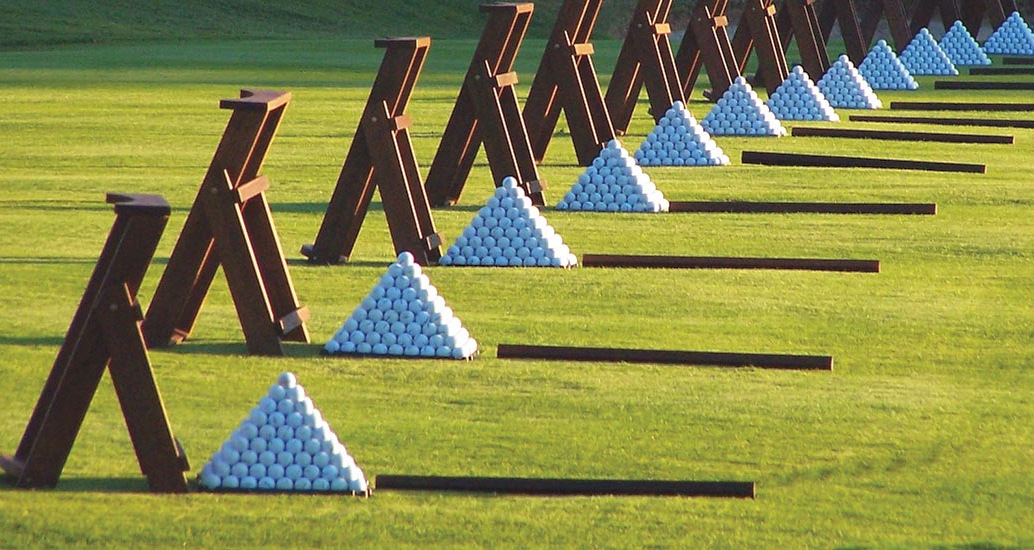IMPROVE MY GAME
Articles
Practice with a Purpose

In the recent book Make It Stick: The Science of Successful Learning, the authors —Peter C. Brown, Henry L. Roedinger III, and Mark A. McDaniel — identify precepts for learning that have been proven repeatedly by scientific research. They begin their discussion of learning by emphasizing the foundational importance of memory:
“First, to be useful, learning requires memory, so what we’ve learned is still there later when we need it.” (p. 2).
“Second, we need to keep learning and remembering all our lives.” (p. 2).
As players develop their swings, they are introduced to new techniques. Over time they refine those techniques to make them applicable in different circumstances and reliable under competitive pressure.
Pia Nilsson and Lynn Marriott of Vision 54 understand this progression. They have their students write down a description of their swing during their best rounds. By writing such a description, players develop awareness of the movements of their swing, take note of its signature elements and account for sequence. Players then have an inspected memory of their optimal swing; they have their swing in front of them as a beginning place for repetition, analysis, refinement or revision.
It is this process Manual de la Torre’s father recommended to him: “Son, if you know what you are doing and it works, spend the rest of your life perfecting it, and remember that if you should miss a shot, it simply means that you did something wrong, so get back to what to what you should do.” (Torre, Understanding the Golf Swing, p. 66).
(RELATED TPI ARTICLE: "What You Can Learn From Seve" by Andy Griffiths)
Brown, Roedinger and McDaniel remind us that “learning is an acquired skill, and the most effective strategies are often counterintuitive.” (p. 2). Among such counterintuitive strategies are these four:
- “When learning is harder, it’s stronger and lasts longer.” (p. 9).
- “When you’re adept at extracting the underlying principles or ‘rules’ that differentiate types of problems, you’re more successful at picking the right solution in unfamiliar situations.” (p. 4).
- “In virtually all areas of learning, you build better mastery when you use testing as a tool to identify and bring up your areas of weakness.” (p. 5).
- “When you space out practice at a task and get a little rusty between sessions, or you interleave the practice of two or more subjects, retrieval is harder and feels less productive, but the effort produces longer lasting learning and enables more versatile application of it in later settings” (p. 4).
As players relate these precepts to sound training in their own sport, certain approaches to practice are confirmed or recommend themselves:
- Rather than simply allot an amount of time to work on different aspects of one’s game, create “gateway practices” where players must accomplish one task before they are allowed to move on to another task. Only after getting up and down from four different spots can they move on to, say, lag putting drills or time on the range. Only after completing the star drill with 8 balls — or for Phil Mickelson, 100 balls — can they call the practice session complete.
- Layer lessons or drills so that what the players have just given attention to is the basis for what they give attention to next. Following this logic, a lesson on bunker shots moves to a lesson on the similar swing needed for hitting out of deep rough. The player develops the technique for the first shot and extrapolates the underlying principles from that shot to apply to the second shot. With this layering, the focus is not simply on developing two discrete and unrelated techniques, but on having the player develop “shot sense” — an understanding of shot making he or she can apply everywhere in a round.
- Rather than present players with a “perfected technique” for a particular shot, have them think through the task in front of them and have them figure out the adjustments they need to make for the circumstance. For a downhill bunker shot, how should they set up to deliver the club effectively through the shot? How can they get the ball up in the air quickly and create enough spin to hold the green? Through question-and-answer rather than direct instruction, players own the insights they make and come to rely on themselves to make decisions in unfamiliar circumstances or in competition.
- Have regular sessions when players test their current skills to monitor progress and to determine the focus of future practice sessions. With such tests, players have discrete, reliable data on what they can do well and what they need to work on in the coming days. After performing the same short game test once each week, for example, players can design meaningful practice sessions, see progress over time and in competition, trust that they have a specific shot when they need it.
- It is well known that players improve more readily not by hitting the same shot with the same club over and over again, but by selecting different clubs and different targets.
Such a practice asks players to continually revisit the fundamentals of shot making and more closely imitate the experience of playing a round of golf.
Make It Stick confirms this insight and further encourages players to organize practice sessions or a series of practices so that there is intentionally brief inattention to aspects of one’s game.
As players “get a little rusty” between sessions, they actually improve skill acquisition. Ben Hogan famously said, “there isn’t enough daylight in any one day to practice all the shots you need to.” Knowing that one learns better by forgetting and remembering, players do not need to design practices that include all aspects of their game each day.
In fact, doing so limits one’s game.
Improving as a competitive golfer is a “journey of mastery.” In the short view, players wish to perform well under championship pressure and to win now. In the long view, players understand that over time they are developing as complete golfers, as athletes, as competitors and as individuals.
- Bill O'Neill
In the words of Brown, Roedinger, and McDaniel, “Mastery in any field . . . is a gradual accretion of knowledge, conceptual understanding, judgment, and skill. These are the fruits of variety in the practice of new skills, and of striving, reflection, and mental rehearsal.” (p. 18).

Bill O'Neill is the former Head Golf Coach at University School in Cleveland, Ohio, and during his tenure his teams won four Division II State Championships in six years and two players won individual state championships. Graduates of his program continued on to play at Northwestern, Virginia, the Naval Academy, Elon, Dayton, and William and Mary. Bill has spoken on junior golf at the World Golf Fitness Summit and is Level 3 TPI Certified in Golf, Fitness, and Junior Golf. Bill earned his BA in English at The Ohio State University and his MA and PhD in English at Yale University. He has taught English and coached track, cross country, and then golf at University School and is currently the Assistant Headmaster and Academic Dean K-12. He continues to work with players on an individual basis. To contact Bill, email him at woneil@us.edu.